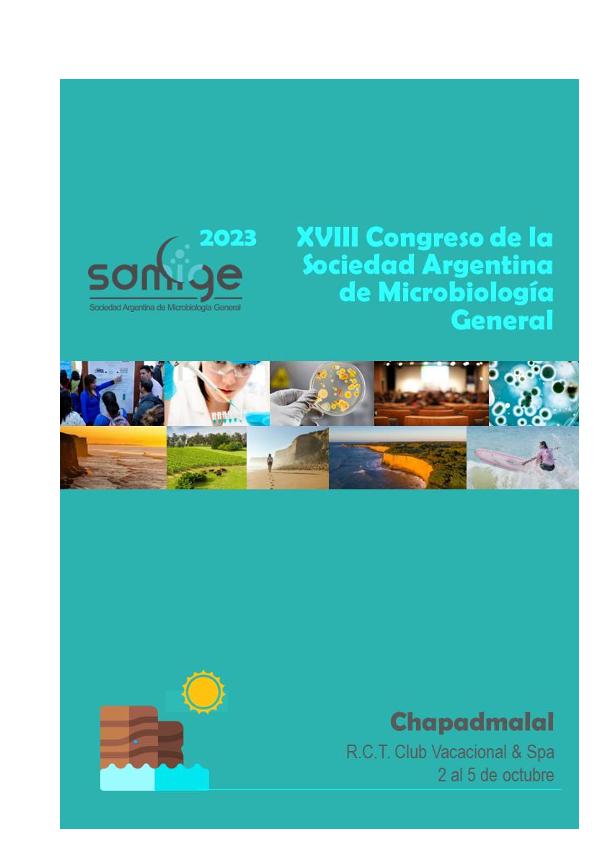Mostrar el registro sencillo del ítem
dc.contributor.author
Rasuk, Maria Cecilia

dc.contributor.author
Pisa, José Horacio

dc.contributor.author
Chacón, Florencia Isabel

dc.contributor.author
Pereyra, Martina María

dc.contributor.author
Dib, Julian Rafael

dc.date.available
2023-11-06T18:25:34Z
dc.date.issued
2023
dc.identifier.citation
Impact of biocontrol yeast clavispora lusitaniae 146 on the lemon microbiome; XVIII Congreso de la Sociedad Argentina de Microbiología General; Chapadmalal; Argentina; 2023; 184-185
dc.identifier.uri
http://hdl.handle.net/11336/217235
dc.description.abstract
The use of biocontrol agents has been proposed as an effective alternative to reduce citrus decays for promoting sustainable agriculture based on organic fruit production. Among the different microbial biocontrol agents, Clavispora lusitaniae 146 stands out as it is able of effectively controlling green mold in lemons. Although there is growing recognition of the role that the microbiome plays in the health and physiology of many plant species, to date, the composition of the lemon microbiome is unknown, nor is the effect of yeast 146 on it. Thus, the aim of this research was to study the impacts of biocontrol yeast Clavispora lusitaneae 146 on the composition of the lemon microbiome. Lemons were harvested, and then divided into two treatments: untreated and treated lemons with biocontrol yeast C. lusitaneae 146. Fruits were then stored at room temperature for 7 days. DNA was extracted from a pool of 3 pieces of peel per sample, and used for PCR that amplified the bacterial hypervariable V3-V4 region of the 16S rRNA gene. Paired-end sequencing of amplicons was done on an Illumina MiSeq sequencer. To assess the effects of postharvest treatment and storage on the diversity of the lemon microbiome, we used a series of ANOVA and adonis (~PERMANOVA) models with Shannon diversity and community composition as the response variables, respectively. There was no statistically significant difference (KruskalWallies, p > 0.05) in bacterial diversity between the treated and untreated fruits. In this sense, the application of Clavispora lusitaneae 146 did not produce significant changes on bacterial communities of lemons during storage, including alpha diversity, community composition and structure. The bacterial community was dominated by roteobacteria,followed by Firmicutes and Actinobacteria. Specific bacterial taxa were only identified for untreated lemons: Methylobacteriaceae (Alphaproteobacteria) and unclassified bacteria, however in a low abundance. Here, we presented the first lemon microbiome and we showed that the microbial abundance, diversity, and community structures were not significantly different for both treatments, revealing that Clavispora lusitaniae 146 didn´t modify the native bacterial population of the fruit microbiome. The present study is part of larger project whose objectives are to define the complete lemon microbiome, assess the effects of the postharvest biocontrol agents on the composition of the lemon microbiome to develop a science-based strategy for manipulating this microbiome to prevent postharvest decay and physiological disorders.
dc.format
application/pdf
dc.language.iso
eng
dc.publisher
Sociedad Argentina de Microbiología General
dc.rights
info:eu-repo/semantics/openAccess
dc.rights.uri
https://creativecommons.org/licenses/by-nc-sa/2.5/ar/
dc.subject
MICROBIOME
dc.subject
LEMON
dc.subject
BIOCONTROL
dc.subject.classification
Ecología

dc.subject.classification
Ciencias Biológicas

dc.subject.classification
CIENCIAS NATURALES Y EXACTAS

dc.title
Impact of biocontrol yeast clavispora lusitaniae 146 on the lemon microbiome
dc.type
info:eu-repo/semantics/publishedVersion
dc.type
info:eu-repo/semantics/conferenceObject
dc.type
info:ar-repo/semantics/documento de conferencia
dc.date.updated
2023-11-01T15:30:21Z
dc.journal.pagination
184-185
dc.journal.pais
Argentina

dc.journal.ciudad
Cordoba
dc.description.fil
Fil: Rasuk, Maria Cecilia. Consejo Nacional de Investigaciones Científicas y Técnicas. Centro Científico Tecnológico Conicet - Tucumán. Planta Piloto de Procesos Industriales Microbiológicos; Argentina
dc.description.fil
Fil: Pisa, José Horacio. Consejo Nacional de Investigaciones Científicas y Técnicas. Centro Científico Tecnológico Conicet - Tucumán. Planta Piloto de Procesos Industriales Microbiológicos; Argentina
dc.description.fil
Fil: Chacón, Florencia Isabel. Consejo Nacional de Investigaciones Científicas y Técnicas. Centro Científico Tecnológico Conicet - Tucumán. Planta Piloto de Procesos Industriales Microbiológicos; Argentina
dc.description.fil
Fil: Pereyra, Martina María. Consejo Nacional de Investigaciones Científicas y Técnicas. Centro Científico Tecnológico Conicet - Tucumán. Planta Piloto de Procesos Industriales Microbiológicos; Argentina
dc.description.fil
Fil: Dib, Julian Rafael. Consejo Nacional de Investigaciones Científicas y Técnicas. Centro Científico Tecnológico Conicet - Tucumán. Planta Piloto de Procesos Industriales Microbiológicos; Argentina. Universidad Nacional de Tucumán. Facultad de Bioquímica, Química y Farmacia. Instituto de Microbiología; Argentina
dc.relation.alternativeid
info:eu-repo/semantics/altIdentifier/url/https://samige.org.ar/wp-content/uploads/2023/09/Libro-de-Resumenes-Final.pdf
dc.conicet.rol
Autor

dc.conicet.rol
Autor

dc.conicet.rol
Autor

dc.conicet.rol
Autor

dc.conicet.rol
Autor

dc.coverage
Internacional
dc.type.subtype
Congreso
dc.description.nombreEvento
XVIII Congreso de la Sociedad Argentina de Microbiología General
dc.date.evento
2023-10-02
dc.description.ciudadEvento
Chapadmalal
dc.description.paisEvento
Argentina

dc.type.publicacion
Book
dc.description.institucionOrganizadora
Sociedad Argentina de Microbiología General
dc.source.libro
Libro de resúmenes del XVIII Congreso de la Sociedad Argentina de Microbiología General
dc.date.eventoHasta
2023-10-05
dc.type
Congreso
Archivos asociados
